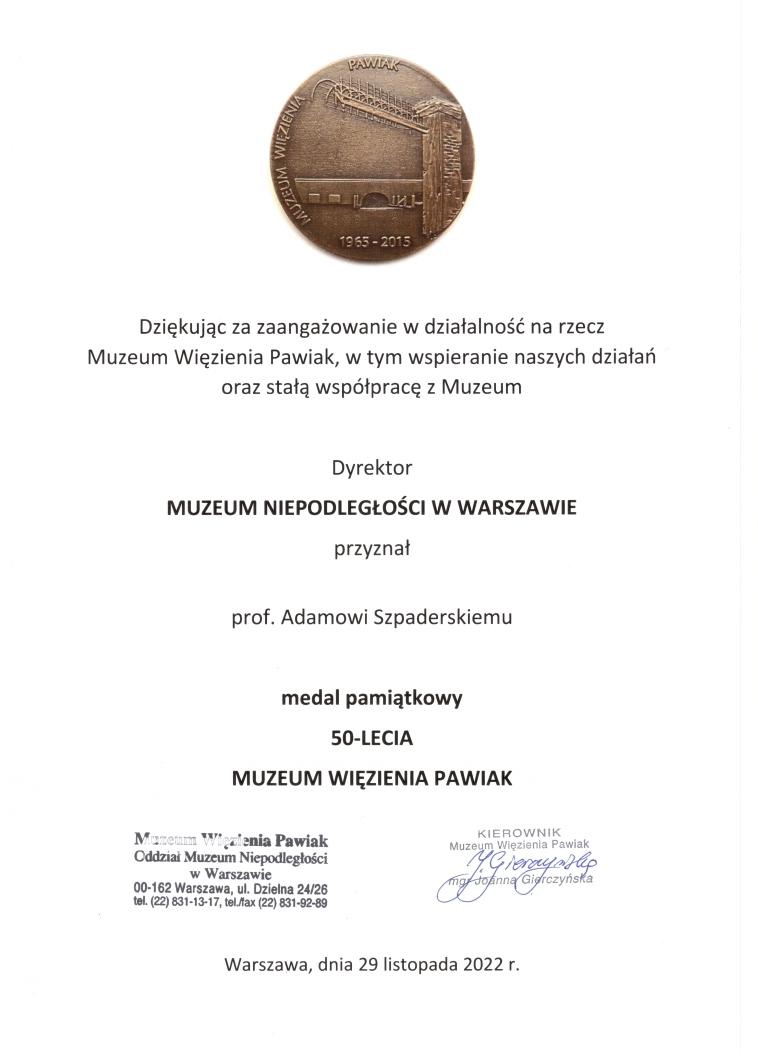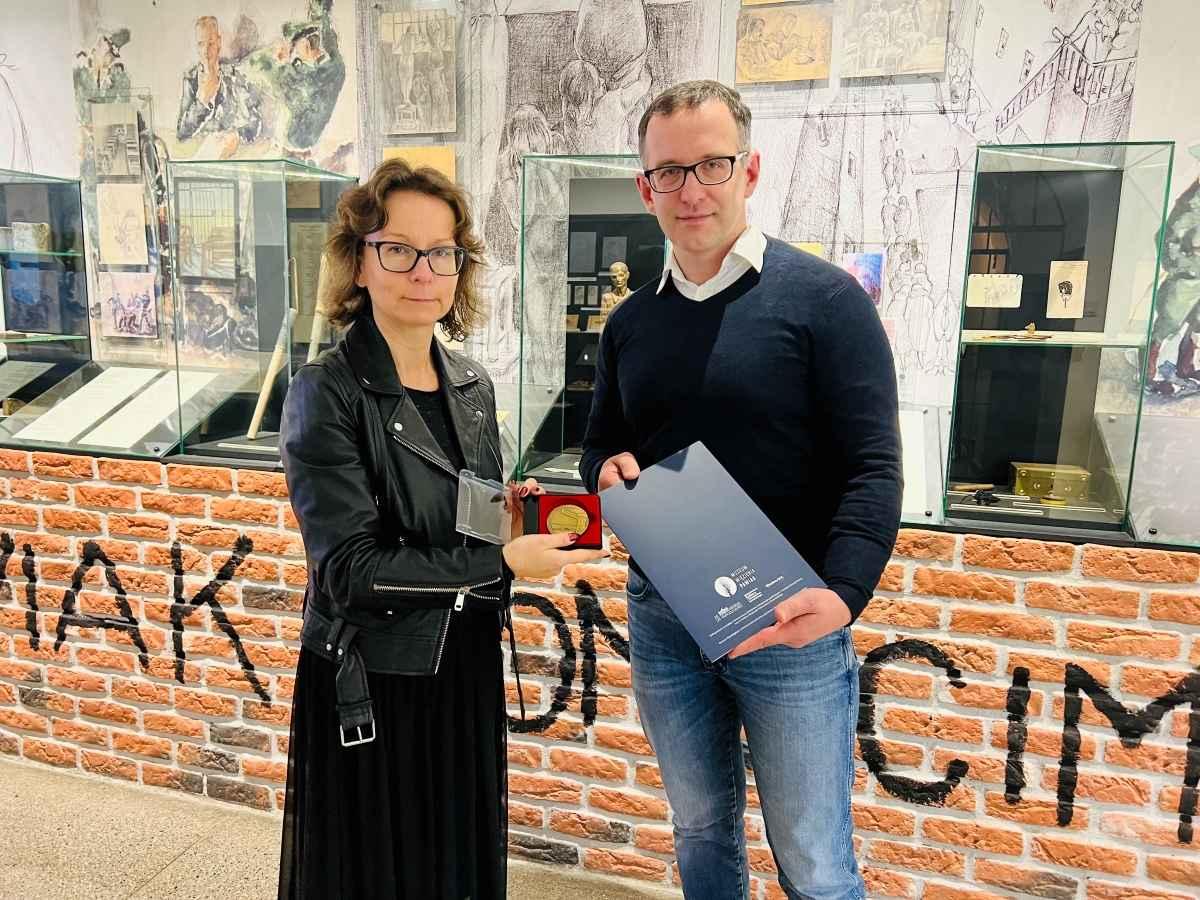Contributing expertise of the Center for Research on the Economics and Memorial Sites
For several years, Professor Adam Szpaderski has been researching the economic, financial, and management processes related to the development, preservation, commemoration, and functioning of memorial sites around the world. This unique expertise is becoming increasingly important as nations and societies come to understand the importance of the preservation of memorial sites and their role in the education process of new generations. Contributing the knowledge developed by the Center to various museums and memorial sites is part of the Center’s mission.
Medal on the occasion of the 50th Anniversary of the Museum of Pawiak Prison
 Diploma issued by the Museum of Independence
Diploma issued by the Museum of Independence
This medal is very meaningful to me, because it confirms that my work contributes to the preservation of the memory of those who perished and suffered in this tragic place — the place that was a central institution in the genocide system perpetrated by the Germans against the civilian population of Warsaw and its surrounding areas during World War II.

Adam Szpaderski, Ph.D. / Associate Professor, Head of the Center for Research on the Economics of Memorial Sites
Professor Szpaderski accepted the medal during the 57th anniversary of the Pawiak Prison Museum.
 Prof. Adam Szpaderski and Joanna Gierczyńska, head of the Museum of Pawiak Prison
Prof. Adam Szpaderski and Joanna Gierczyńska, head of the Museum of Pawiak Prison
Adam Szpaderski, Ph.D. / Associate Professor
Professor Adam Szpaderski specializes in strategic management, management of memorial sites, management of education about Auschwitz, the Holocaust and genocides, and parameterization of cultural heritage institutions. He is Dean’s Representative and the Chairman of the Committee for Internationalization of Education Offer of the Faculty of Social Sciences in Warsaw, and the Head of the Center for Research on the Economics of Memorial Sites at SWPS University, and the head of the graduate certificate program “The Roots of the 20th Century Totalitarianism: Auschwitz – Holocaust – Genocides.”
Professor Szpaderski is also the Chief Consultant for Strategy and Education Management at the Auschwitz-Birkenau State Museum in Oświęcim, Chairman of the Council of the Gross-Rosen Museum in Rogoźnica, Education Strategy Advisor at the Stutthof Museum in Sztutowo and Senior Consultant to the Central Museum of Prisoners-of-War.
In addition, he is the head of many implementation projects, and a member of scientific associations devoted to economics, management and culture. He is also a recipient of numerous awards.
More information
The Museum of Pawiak Prison
The Pawiak Prison was built in Warsaw in the first half of the 19th century as the main prison for political prisoners and criminals. At that time, Warsaw was the capital of the Congress Kingdom of Poland, which was a puppet state in a personal union with the Russian Empire. At the time, Poland did not exist as an independent state as a result of the 18th-century partitions (Polish territory, with its native population, was split between the Habsburg monarchy, the Kingdom of Prussia, and the Russian Empire). During the January 1863 Uprising, the prison served as a transfer camp for Poles sentenced by Imperial Russia to deportation to Siberia.
Following the 1939 German invasion of Poland, the Pawiak Prison became a German Gestapo prison, the largest and cruelest political prison in the General Government, also referred to as the General Governorate for the Occupied Polish Region, encompassing central Poland, which was established by Nazi Germany in October 1939. The number of Pawiak victims is estimated at nearly 37,000 people murdered, and about 60,000 individuals sent to concentration camps, prisons, or forced labor in the Third Reich. In 1944, the Pawiak Prison was destroyed during the Warsaw Uprising.
The Museum of Pawiak Prison was established in 1965 on the initiative and with the participation of former political prisoners of Pawiak. The museum building was erected on the surviving underground foundations of casemates VII and VIII. The main goal of the museum is to commemorate, document, and disseminate the history of Pawiak Prison, with a focus on the martyrdom and death of thousands of Poles during the German terror in occupied Warsaw from 1939 to 1944.
Since 1990, the Pawiak Prison Museum along with the Mausoleum of Struggle and Martyrdom, has been a branch of the Museum of Independence in Warsaw.
Related information
Professor Adam Szpaderski appointed Chairman of the Board of the Prisoners-of-War Remembrance League
Professor Adam Szpaderski appointed Senior Consultant to the Central Museum of Prisoners-of-War
Prof. Adam Szpaderski Appointed Adviser for Strategic Development of NOSPR
Prof. Adam Szpaderski Appointed Education Strategy Advisor to Stutthof Museum
Prof. Adam Szpaderski Appointed to Gross-Rosen Museum Council
Prof. Adam Szpaderski Appointed Chief Consultant of Auschwitz-Birkenau Museum
Prof. Adam Szpaderski appointed to Sybilla Competition jury